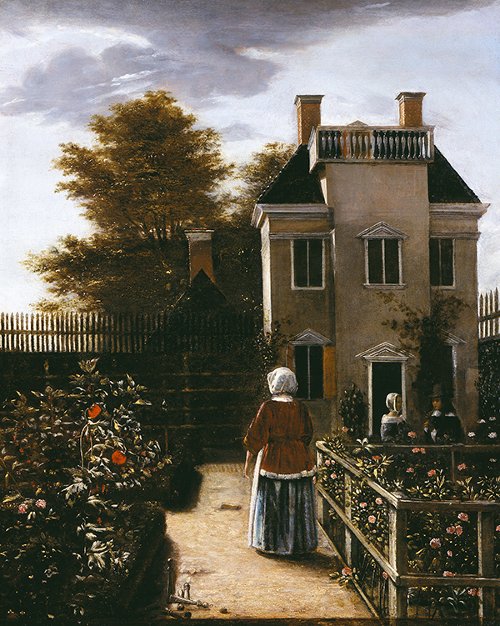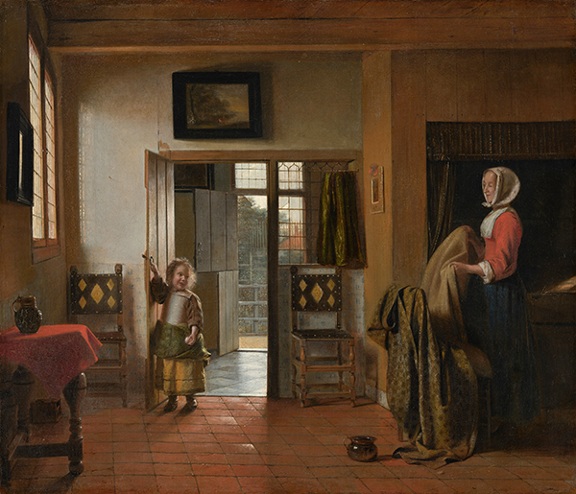Gem of the Month: Pieter de Hooch
Gardens are probably not in full bloom as yet, but I cannot resist showing this idyllic garden genre scene by Pieter de Hooch. Did you ever want to crawl right into a painting to experience the atmosphere the artist rendered? Happens to me all the time. Few Dutch Baroque genre scene artists achieved the level of complacent stillness that De Hooch managed to express. The Dutch of this period were proud of their flourishing economy and prosperous middle class, and De Hooch’s works give us a visual explanation of why.
 |
| Pieter de Hooch (1629–1684, Netherlands), Flower Garden, ca. 1660. Oil on panel, 20 ½" x 17 3⁄16" (52.1 x 43.7 cm). © 2024 Brooklyn Museum, New York, gift of the Executors of the Estate of Colonel Michael Friedsam. (BMA-699) |
De Hooch worked mainly in Delft, where he seems to have influenced Johannes Vermeer (1632–1675). While his works can recall the atmospheric lighting of Vermeer, De Hooch preferred golden tones to the silvery tones that dominate Vermeer's work. It was during this Delft period that De Hooch painted his interiors, favoring two or three figures in a domestic setting, and outdoor scenes of courtyards and gardens. De Hooch's paintings of this time are characterized by a sensitive rendering of space, light, and atmosphere, as well as a precision that gives them a sense of untroubled stillness and order.
In garden scenes such as Flower Garden, the space tends to be sectioned off into planes with an emphasis on a dramatic use of one-point perspective to define the space. This was the influence of Carel Fabritius (1622–1654), a student of Rembrandt van Rijn (1606–1669) with whom De Hooch studied in Delft. These garden and courtyard scenes were executed without sentimentality. He emphasized a complex construction of space using geometric shapes such as the fences in Flower Garden, which not only lead the eye into the composition with the one-point perspective, but also separate the foreground from the background.
 |
| Pieter de Hooch, The Bedroom, 1658/1660. Oil on canvas, 20" x 23 ⅝" (51 x 60 cm). © 2024 National Gallery of Art, Washington, DC, Widener Collection. (NGA-P0717) |
The majority of Dee Hooch’s genre scenes are cozy interiors lit by cozy fires or candles. In The Bedroom, the light flows through windows. Typical of his ode to middle class women, this scene portrays a woman arranging a room for day use—a multifunctional room rather than a bedroom—emphasizing her dual role as nurturing mother and home caretaker, the Dutch Baroque idea of domestic bliss. This may be a portrait of De Hooch's wife, Jannetje, and either his son, Peter, or daughter, Anna (both genders wore skirts as toddlers).
Like his garden scenes, De Hooch created a clear sense of space in his interior scenes using one-point perspective. Formal elements such as the effects of light on the space, variations of tone in subdued lighting, and geometric shapes as seen in the tiles of the floor are emphasized in The Bedroom. Light shining through the windows and the lines created by the tiles lead the eye to the young child.
Art created during the period that followed the Renaissance (ca. 1400–1600) in Western Europe is referred to as Baroque (ca. 1600–1750). No one style or set of stylistic principles define this period. The term comes from barocco, a Portuguese word for an irregular pearl. Art critics in the 1800s coined the term to disparage some of the unstructured, overornamented, theatrical, and grotesque art of the post-Renaissance period.
During the Baroque period, a variety of stylistic trends co-existed and often intermingled. The major trends were naturalism (bourgeois), classicism, and drama. After Spanish domination since 1516, the Dutch provinces declared independence from Spain in 1581, establishing the Dutch Republic. While the southern Lowlands—Flanders (now Belgium) and Luxembourg—remained Catholic countries, the provinces of the Netherlands were Protestant after the Reformation (ca. 1517–1600).
Dutch art of the Baroque period maintained the same ideals of naturalism and detail as Northern Renaissance painting. However, in contrast to Catholic countries, Dutch artists developed their own hierarchy of subjects and styles, reflecting their reformed religion and the absence of a dominating church. Calvinistic Protestantism swept away any classical, historical, or religious subjects, emphasizing the predominant middle-class culture.
While some religious subjects persisted, portraiture, genre scenes, landscape, and still life became the predominant subjects. Dutch Baroque painting united the realism of Jan van Eyck (1390–1441) with the new realism of light and dark brought back by Dutch artists who had studied Caravaggio’s (1571–1610) style in Italy. In Dutch Baroque painting, the whole visual world was explored in scrupulous faithfulness.
De Hooch was born outside of Rotterdam to a village butcher who also painted. He was the pupil of Nicolaes Berchem (1620–1683) in Haarlem. At the age of 23 he moved to Delft, where he became the brother-in-law of one of Rembrandt’s pupils, Hendrick van der Burch (1627–1664). When he moved to Amsterdam in 1667, he continued his interior views with a focus on more affluent households. He continued to paint intimate interior scenes until his death.
Correlations to Davis programs: Explorations in Art 2E Grade 5: 1.7, 1.8; Explorations in Art 2E Grade 6: 1.4; Experience Art: 2.1; A Community Connection 2E: 2.1; A Global Pursuit 2E: 5.1, 5.4; A Personal Journey 2E: 2.1, 2.3; Discovering Art History 4E: 11.3


Comments